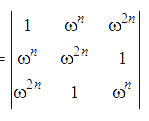Elements of a matrix A of order 10 x 10 are defined as aij=ωi+j (where omega is cube root unity), then tr(A) of matrix is
0
1
3
none of these
The correct Answer is:D
To solve the problem, we need to find the trace of the matrix A defined by its elements aij=ωi+j, where ω is a cube root of unity. The trace of a matrix is the sum of its diagonal elements.
1. Understanding the Matrix Elements:
The elements of the matrix A are given by aij=ωi+j. Therefore, the diagonal elements (where i=j) will be aii=ωi+i=ω2i.
2. Identifying the Diagonal Elements:
For a 10×10 matrix, the diagonal elements will be:
a11=ω2,a22=ω4,a33=ω6,a44=ω8,a55=ω10,a66=ω12,a77=ω14,a88=ω16,a99=ω18,a1010=ω20
3. Calculating the Trace:
The trace tr(A) is the sum of these diagonal elements:
tr(A)=ω2+ω4+ω6+ω8+ω10+ω12+ω14+ω16+ω18+ω20
4. Using Properties of Cube Roots of Unity:
Since ω is a cube root of unity, we know that ω3=1. Thus, we can simplify the powers of ω:
- ω10=ω3⋅3+1=ω1=ω
- ω12=ω3⋅4=1
- ω14=ω3⋅4+2=ω2
- ω16=ω3⋅5+1=ω
- ω18=ω3⋅6=1
- ω20=ω3⋅6+2=ω2
5. Grouping the Terms:
Now, we can rewrite the trace:
tr(A)=ω2+ω4+ω6+ω8+ω+1+ω2+ω+1+ω2
Simplifying this gives:
tr(A)=4ω2+3ω+3
6. Final Calculation:
Using the fact that 1+ω+ω2=0, we can express ω+ω2=−1:
tr(A)=4ω2+3(−1)=4ω2−3
7. Conclusion:
The final result for the trace of the matrix A is:
tr(A)=ω2
The elements of the matrix A are given by aij=ωi+j. Therefore, the diagonal elements (where i=j) will be aii=ωi+i=ω2i.
For a 10×10 matrix, the diagonal elements will be:
a11=ω2,a22=ω4,a33=ω6,a44=ω8,a55=ω10,a66=ω12,a77=ω14,a88=ω16,a99=ω18,a1010=ω20
The trace tr(A) is the sum of these diagonal elements:
tr(A)=ω2+ω4+ω6+ω8+ω10+ω12+ω14+ω16+ω18+ω20
Since ω is a cube root of unity, we know that ω3=1. Thus, we can simplify the powers of ω:
- ω10=ω3⋅3+1=ω1=ω
- ω12=ω3⋅4=1
- ω14=ω3⋅4+2=ω2
- ω16=ω3⋅5+1=ω
- ω18=ω3⋅6=1
- ω20=ω3⋅6+2=ω2
Now, we can rewrite the trace:
tr(A)=ω2+ω4+ω6+ω8+ω+1+ω2+ω+1+ω2
Simplifying this gives:
tr(A)=4ω2+3ω+3
Using the fact that 1+ω+ω2=0, we can express ω+ω2=−1:
tr(A)=4ω2+3(−1)=4ω2−3
The final result for the trace of the matrix A is:
tr(A)=ω2
Topper's Solved these Questions
- BOOK - CENGAGE ENGLISHCHAPTER - MATRICESEXERCISE - Multiple Correct Answer49videos
MATRICES
- BOOK - CENGAGE ENGLISHCHAPTER - MATRICESEXERCISE - Linked Comprehension Type27videos
MATRICES
- BOOK - CENGAGE ENGLISHCHAPTER - MATRICESEXERCISE - CAE 13.517videos
MATRICES
- BOOK - CENGAGE ENGLISHCHAPTER - MATHMETICAL REASONINGEXERCISE - Archives10videos
MATHMETICAL REASONING
- BOOK - CENGAGE ENGLISHCHAPTER - METHODS OF DIFFERENTIATIONEXERCISE - Single Correct Answer Type46videos
METHODS OF DIFFERENTIATION
Similar Questions
If ω is a cube root of unity, then
1+ω= …..View SolutionIf ω is a cube root of unity, then
ω3= ……View SolutionIf ω is a cube root of unity, then
1+ω2= …..View Solutionconstrust a matrix of order 2×2 whose elements are defined as aij=i+3j.
View SolutionIf ω is a cube root of unity, then
ω+ω2=…..View SolutionIf A=[ω00ω], where ω is cube root of unity, then what is A100 equal to ?
View SolutionIf a square matix a of order three is defined A=[aij] where aij=sgn(i−j), then prove that A is skew-symmetric matrix.
View SolutionIf 1,ω,ω2 are the cube roots of unity, then △

is equal to.....View SolutionIf A=⎛⎜⎝1111ω2ω1ωω2⎞⎟⎠ where ω is a complex cube root of unity then adj−A equals
View SolutionIf 1,ω,ω2 are three cube roots of unity, prove that
(1+ω2)4=ωView Solution
